Deck 12: Lipids: Structure and Function
Question
Question
Question
Question
Question
Question
Question
Question
Question
Question
Question
Question
Question
Question
Question
Question
Question
Question
Question
Question
Question
Question
Question
Question
Question
Question
Question
Question
Question
Question
Question
Question
Question
Question
Question
Question
Question
Question
Question
Question
Question
Question
Question
Question
Question
Question
Question
Question
Question
Question
Question
Question
Question
Question
Question
Question
Question
Question
Question
Question
Question
Question
Question
Question
Question
Question
Question
Question
Question
Question
Question
Question
Question
Question
Question
Question
Question
Question
Question
Question

Unlock Deck
Sign up to unlock the cards in this deck!
Unlock Deck
Unlock Deck
1/108
Play
Full screen (f)
Deck 12: Lipids: Structure and Function
1
Which of the following molecules are anabolic steroids?  I II III
I II III
A) All of these are anabolic steroids.
B) Both II and IIII are anabolic steroids.
C) Only III is an anabolic steroid.
D) Both I and III are anabolic steroids.
E) None of these are anabolic steroids.
 I II III
I II IIIA) All of these are anabolic steroids.
B) Both II and IIII are anabolic steroids.
C) Only III is an anabolic steroid.
D) Both I and III are anabolic steroids.
E) None of these are anabolic steroids.
Both I and III are anabolic steroids.
2
Which of the following type of molecule is not a lipid?
A) amino acid
B) triglyceride
C) phospholipid
D) steroid
E) eicosanoid
A) amino acid
B) triglyceride
C) phospholipid
D) steroid
E) eicosanoid
amino acid
3
Which of the following lists of features best describes the structure of a naturally occurring fatty acid? 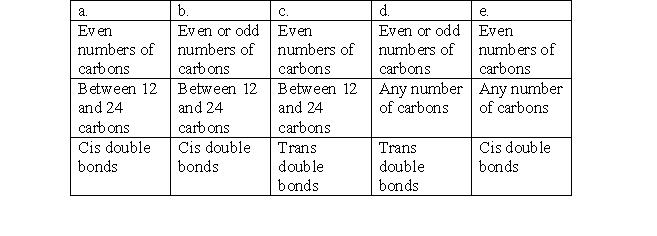
A) a
B) b
C) c
D) d
E) e

A) a
B) b
C) c
D) d
E) e
a
4
The role of hormones in the body is to
A) regulate body temperature.
B) serve as a chemical messenger.
C) store energy.
D) catalyze chemical reactions.
E) transport key molecules.
A) regulate body temperature.
B) serve as a chemical messenger.
C) store energy.
D) catalyze chemical reactions.
E) transport key molecules.

Unlock Deck
Unlock for access to all 108 flashcards in this deck.
Unlock Deck
k this deck
5
Which of the following statements best describes the purpose of triacylglycerides in the body?
A) Triacylglycerides are a reservoir of long-term energy.
B) Triacylglycerides are a reservoir of short-term energy.
C) Triacylglycerides are chemical messengers.
D) Triacylglycerides are the main components of cell walls.
E) Triacylglycerides are important components of our diet, but do not have a purpose in the body.
A) Triacylglycerides are a reservoir of long-term energy.
B) Triacylglycerides are a reservoir of short-term energy.
C) Triacylglycerides are chemical messengers.
D) Triacylglycerides are the main components of cell walls.
E) Triacylglycerides are important components of our diet, but do not have a purpose in the body.

Unlock Deck
Unlock for access to all 108 flashcards in this deck.
Unlock Deck
k this deck
6
How does a double bond in a fatty acid change the overall structure of the fatty acid?
A) The overall structure does not change.
B) The more double bonds a fatty acid has, the more linear it is.
C) The more double bonds a fatty acid has, the more flexible it is.
D) The more double bonds a fatty acid has, the more bent or kinked it is.
E) The more double bonds a fatty acid has, the more twisted it is.
A) The overall structure does not change.
B) The more double bonds a fatty acid has, the more linear it is.
C) The more double bonds a fatty acid has, the more flexible it is.
D) The more double bonds a fatty acid has, the more bent or kinked it is.
E) The more double bonds a fatty acid has, the more twisted it is.

Unlock Deck
Unlock for access to all 108 flashcards in this deck.
Unlock Deck
k this deck
7
Which of the following types of lipids are fats and oils?
A) triglyceride
B) phospholipid
C) glycolipid
D) steroid
E) eicosanoid
A) triglyceride
B) phospholipid
C) glycolipid
D) steroid
E) eicosanoid

Unlock Deck
Unlock for access to all 108 flashcards in this deck.
Unlock Deck
k this deck
8
Which of the following is not a steroid?
A) insulin
B) androgens
C) estrogens
D) cholesterol
E) testosterone
A) insulin
B) androgens
C) estrogens
D) cholesterol
E) testosterone

Unlock Deck
Unlock for access to all 108 flashcards in this deck.
Unlock Deck
k this deck
9
Which statement best describes the meaning of "saturated" as it relates to fatty acids?
A) "Saturated" means that the fatty acid is hydrated.
B) "Saturated" means that the fatty acid is dissolved in water.
C) "Saturated" means that the fatty acid is bent or kinked.
D) "Saturated" means that the fatty acid has many carboxylic acids.
E) "Saturated" means that the fatty acid has the maximum number of hydrogens possible.
A) "Saturated" means that the fatty acid is hydrated.
B) "Saturated" means that the fatty acid is dissolved in water.
C) "Saturated" means that the fatty acid is bent or kinked.
D) "Saturated" means that the fatty acid has many carboxylic acids.
E) "Saturated" means that the fatty acid has the maximum number of hydrogens possible.

Unlock Deck
Unlock for access to all 108 flashcards in this deck.
Unlock Deck
k this deck
10
Which of the statements below best describes the following structure? 
A) This is the structure of an anabolic steroid.
B) This is the structure of testosterone.
C) This is the structures of the backbone of all steroids.
D) This is the structure of the backbone of all lipids.
E) This is cholesterol.

A) This is the structure of an anabolic steroid.
B) This is the structure of testosterone.
C) This is the structures of the backbone of all steroids.
D) This is the structure of the backbone of all lipids.
E) This is cholesterol.

Unlock Deck
Unlock for access to all 108 flashcards in this deck.
Unlock Deck
k this deck
11
Which of the following types of lipids are derived from fatty acids and are involved in the body's inflammatory response?
A) triglyceride
B) phospholipid
C) glycolipid
D) steroid
E) eicosanoid
A) triglyceride
B) phospholipid
C) glycolipid
D) steroid
E) eicosanoid

Unlock Deck
Unlock for access to all 108 flashcards in this deck.
Unlock Deck
k this deck
12
Which of the following is NOT a side effect of anabolic steroid use?
A) infertility
B) testicular atrophy
C) cardiovascular disease
D) prostate cancer
E) excessive growth in teenagers
A) infertility
B) testicular atrophy
C) cardiovascular disease
D) prostate cancer
E) excessive growth in teenagers

Unlock Deck
Unlock for access to all 108 flashcards in this deck.
Unlock Deck
k this deck
13
Why might an anabolic steroid be prescribed by a doctor?
A) to promote growth in those below average height
B) to treat low testosterone
C) to treat inflammation
D) to treat cancer
E) to treat infection
A) to promote growth in those below average height
B) to treat low testosterone
C) to treat inflammation
D) to treat cancer
E) to treat infection

Unlock Deck
Unlock for access to all 108 flashcards in this deck.
Unlock Deck
k this deck
14
Identify the class of lipid to which the following molecule belongs. 
A) eicosanoid
B) triacylglycerol
C) steroid
D) glycerophospholipid
E) fatty acid

A) eicosanoid
B) triacylglycerol
C) steroid
D) glycerophospholipid
E) fatty acid

Unlock Deck
Unlock for access to all 108 flashcards in this deck.
Unlock Deck
k this deck
15
Which type of lipid is the main component of cell membranes?
A) triglyceride
B) phospholipid
C) glycolipid
D) phospholipids and glycolipids
E) triglycerides and eicosanoid
A) triglyceride
B) phospholipid
C) glycolipid
D) phospholipids and glycolipids
E) triglycerides and eicosanoid

Unlock Deck
Unlock for access to all 108 flashcards in this deck.
Unlock Deck
k this deck
16
A polyunsaturated fatty acid contains multiple
A) ketones.
B) carboxylic acids.
C) carbon-carbon double bonds.
D) alcohols.
E) Any of the above
A) ketones.
B) carboxylic acids.
C) carbon-carbon double bonds.
D) alcohols.
E) Any of the above

Unlock Deck
Unlock for access to all 108 flashcards in this deck.
Unlock Deck
k this deck
17
Match the type of fatty acid with its shape: 
A) a
B) b
C) c
D) d
E) e

A) a
B) b
C) c
D) d
E) e

Unlock Deck
Unlock for access to all 108 flashcards in this deck.
Unlock Deck
k this deck
18
Which of the following molecules is NOT a naturally occurring fatty acid? 
A) a
B) b
C) c
D) d
E) e

A) a
B) b
C) c
D) d
E) e

Unlock Deck
Unlock for access to all 108 flashcards in this deck.
Unlock Deck
k this deck
19
An anabolic steroid functions by
A) binding to the testosterone receptor.
B) initiating a biochemical pathway.
C) producing proteins.
D) making new muscles.
E) All of the above
A) binding to the testosterone receptor.
B) initiating a biochemical pathway.
C) producing proteins.
D) making new muscles.
E) All of the above

Unlock Deck
Unlock for access to all 108 flashcards in this deck.
Unlock Deck
k this deck
20
Which of the following statements describes lipids?
A) Lipids all have the steroid backbone.
B) The body stores excess calories as lipids.
C) Lipids are insoluble in water, but soluble in nonpolar solvents.
D) Lipids are soluble in water, but insoluble in nonpolar solvents.
E) Lipids are insoluble in all solvents.
A) Lipids all have the steroid backbone.
B) The body stores excess calories as lipids.
C) Lipids are insoluble in water, but soluble in nonpolar solvents.
D) Lipids are soluble in water, but insoluble in nonpolar solvents.
E) Lipids are insoluble in all solvents.

Unlock Deck
Unlock for access to all 108 flashcards in this deck.
Unlock Deck
k this deck
21
Which of the fatty acids below has the highest melting point? 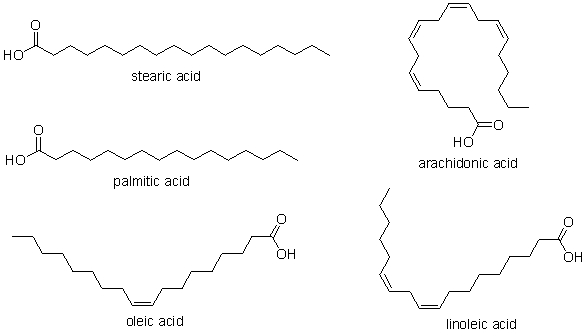
A) stearic acid
B) palmitic acid
C) oleic acid
D) arachidonic acid
E) linoleic acid

A) stearic acid
B) palmitic acid
C) oleic acid
D) arachidonic acid
E) linoleic acid

Unlock Deck
Unlock for access to all 108 flashcards in this deck.
Unlock Deck
k this deck
22
Which of the following choices correctly numbers pinolenic acid (shown below) using the omega system? 
A) omega-5,9,12
B) omega-5
C) omega-3
D) omega-6
E) omega-6,9,13

A) omega-5,9,12
B) omega-5
C) omega-3
D) omega-6
E) omega-6,9,13

Unlock Deck
Unlock for access to all 108 flashcards in this deck.
Unlock Deck
k this deck
23
Triglycerides generally have physical properties
A) similar to the fatty acids from which they are composed.
B) similar to glycerol.
C) very different from the fatty acids from which they are composed.
D) similar to phospholipids.
E) All lipids have the same physical properties.
A) similar to the fatty acids from which they are composed.
B) similar to glycerol.
C) very different from the fatty acids from which they are composed.
D) similar to phospholipids.
E) All lipids have the same physical properties.

Unlock Deck
Unlock for access to all 108 flashcards in this deck.
Unlock Deck
k this deck
24
Which of the following type of triglyceride is the healthiest to eat?
A) monounsaturated
B) polyunsaturated
C) saturated
D) trans fats
E) All fats should be eliminated from the diet.
A) monounsaturated
B) polyunsaturated
C) saturated
D) trans fats
E) All fats should be eliminated from the diet.

Unlock Deck
Unlock for access to all 108 flashcards in this deck.
Unlock Deck
k this deck
25
The following triglyceride is 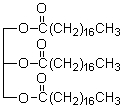
A) a fat because it is unsaturated.
B) a fat because it is saturated.
C) an oil because it is unsaturated.
D) an oil because it is saturated.
E) neither a fat nor an oil.

A) a fat because it is unsaturated.
B) a fat because it is saturated.
C) an oil because it is unsaturated.
D) an oil because it is saturated.
E) neither a fat nor an oil.

Unlock Deck
Unlock for access to all 108 flashcards in this deck.
Unlock Deck
k this deck
26
Which of the following choices correctly numbers linolenic acid (shown below) using the omega system? 
A) a
B) b
C) c
D) d
E) e

A) a
B) b
C) c
D) d
E) e

Unlock Deck
Unlock for access to all 108 flashcards in this deck.
Unlock Deck
k this deck
27
The portion of the molecule that is boxed is called 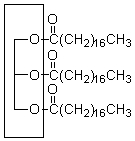
A) the amino acid backbone.
B) the glycerol backbone.
C) the phosphate backbone.
D) a saturated fatty acid.
E) an unsaturated fatty acid.

A) the amino acid backbone.
B) the glycerol backbone.
C) the phosphate backbone.
D) a saturated fatty acid.
E) an unsaturated fatty acid.

Unlock Deck
Unlock for access to all 108 flashcards in this deck.
Unlock Deck
k this deck
28
Identify the class of lipid to which the following molecule belongs. 
A) eicosanoid
B) triacylglycerol
C) steroid
D) glycerophospholipid
E) fatty acid

A) eicosanoid
B) triacylglycerol
C) steroid
D) glycerophospholipid
E) fatty acid

Unlock Deck
Unlock for access to all 108 flashcards in this deck.
Unlock Deck
k this deck
29
An adipocyte stores
A) proteins.
B) triglycerides.
C) white blood cells.
D) red blood cells.
E) carbohydrates.
A) proteins.
B) triglycerides.
C) white blood cells.
D) red blood cells.
E) carbohydrates.

Unlock Deck
Unlock for access to all 108 flashcards in this deck.
Unlock Deck
k this deck
30
Which of the fatty acids shown below are saturated? 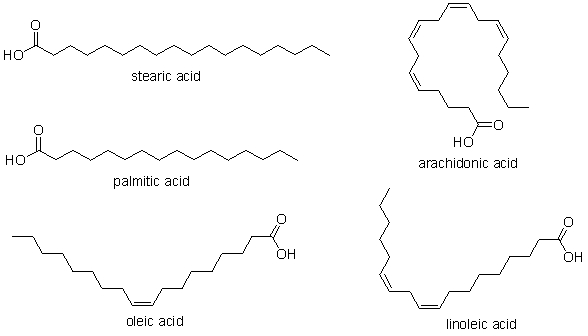
A) stearic acid
B) stearic acid and palmitic acid
C) oleic acid, linoleic acid, and arachidonic acid
D) arachidonic acid
E) All of these are saturated.

A) stearic acid
B) stearic acid and palmitic acid
C) oleic acid, linoleic acid, and arachidonic acid
D) arachidonic acid
E) All of these are saturated.

Unlock Deck
Unlock for access to all 108 flashcards in this deck.
Unlock Deck
k this deck
31
Which of the fatty acids below is a solid at room temperature? 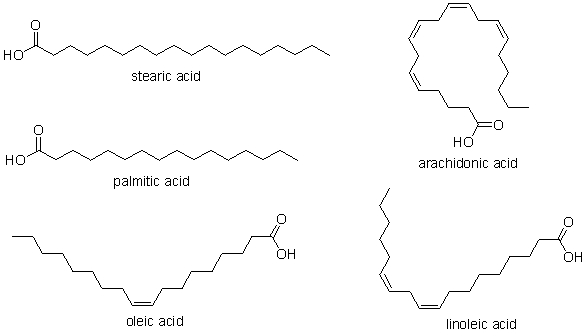
A) stearic acid
B) stearic acid and palmitic acid
C) oleic acid, linoleic acid and arachidonic acid
D) arachidonic acid
E) None of these are solids at room temperature.

A) stearic acid
B) stearic acid and palmitic acid
C) oleic acid, linoleic acid and arachidonic acid
D) arachidonic acid
E) None of these are solids at room temperature.

Unlock Deck
Unlock for access to all 108 flashcards in this deck.
Unlock Deck
k this deck
32
Which of the following choices correctly numbers linolenic acid (shown below) using the delta system? 
A) a
B) b
C) c
D) d
E) e

A) a
B) b
C) c
D) d
E) e

Unlock Deck
Unlock for access to all 108 flashcards in this deck.
Unlock Deck
k this deck
33
The functional group that is circled is called a(n) 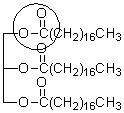
A) ester.
B) ether.
C) carboxylic acid.
D) carbonyl.
E) ketone.

A) ester.
B) ether.
C) carboxylic acid.
D) carbonyl.
E) ketone.

Unlock Deck
Unlock for access to all 108 flashcards in this deck.
Unlock Deck
k this deck
34
Which of the following fatty acids is an essential fatty acid?
A) stearic acid
B) palmitic acid
C) oleic acid
D) arachidonic acid
E) linoleic acid
A) stearic acid
B) palmitic acid
C) oleic acid
D) arachidonic acid
E) linoleic acid

Unlock Deck
Unlock for access to all 108 flashcards in this deck.
Unlock Deck
k this deck
35
The melting point of a fatty acid is determined by _________in the fatty acid.
A) the number of hydrogen bonding functional groups
B) the number of double bonds
C) the number of carbons
D) both the number of carbons and the number of double bonds
E) the number of reactive functional groups
A) the number of hydrogen bonding functional groups
B) the number of double bonds
C) the number of carbons
D) both the number of carbons and the number of double bonds
E) the number of reactive functional groups

Unlock Deck
Unlock for access to all 108 flashcards in this deck.
Unlock Deck
k this deck
36
Where would you most likely find unsaturated fats?
A) They are found in meat.
B) They are found in cheese.
C) They are found in butter.
D) They are found in plants.
E) They are found in margarine.
A) They are found in meat.
B) They are found in cheese.
C) They are found in butter.
D) They are found in plants.
E) They are found in margarine.

Unlock Deck
Unlock for access to all 108 flashcards in this deck.
Unlock Deck
k this deck
37
A triglyceride that is solid at room temperature is called a(n)
A) lipid.
B) oil.
C) eicosanoid.
D) steroid.
E) fat.
A) lipid.
B) oil.
C) eicosanoid.
D) steroid.
E) fat.

Unlock Deck
Unlock for access to all 108 flashcards in this deck.
Unlock Deck
k this deck
38
Triglycerides are insoluble in water because they
A) have extensive nonpolar hydrocarbon structures.
B) have polar carbonyl functional groups.
C) can hydrogen bond with water.
D) are esters.
E) are carboxylic acids.
A) have extensive nonpolar hydrocarbon structures.
B) have polar carbonyl functional groups.
C) can hydrogen bond with water.
D) are esters.
E) are carboxylic acids.

Unlock Deck
Unlock for access to all 108 flashcards in this deck.
Unlock Deck
k this deck
39
Which of the following choices correctly numbers pinolenic acid (shown below) using the omega system? 

A) a
B) b
C) c
D) d
E) e


A) a
B) b
C) c
D) d
E) e

Unlock Deck
Unlock for access to all 108 flashcards in this deck.
Unlock Deck
k this deck
40
Why do unsaturated fatty acids have lower melting points than saturated fatty acids?
A) Unsaturated fatty acids stack better than saturated fatty acids.
B) Saturated fatty acids stack better than unsaturated fatty acids.
C) Unsaturated fatty acids are larger than saturated fatty acids.
D) Saturated fatty acids are larger than unsaturated fatty acids.
E) Unsaturated fatty acids are more flexible than saturated fatty acids.
A) Unsaturated fatty acids stack better than saturated fatty acids.
B) Saturated fatty acids stack better than unsaturated fatty acids.
C) Unsaturated fatty acids are larger than saturated fatty acids.
D) Saturated fatty acids are larger than unsaturated fatty acids.
E) Unsaturated fatty acids are more flexible than saturated fatty acids.

Unlock Deck
Unlock for access to all 108 flashcards in this deck.
Unlock Deck
k this deck
41
Which of the following choices is the definition of "amphipathic"?
A) It refers to a molecule that can be both oxidized and reduced.
B) It refers to a molecule that reacts with its environment.
C) It refers to a molecule that has two reactive sites.
D) It refers to a molecule that makes bubbles.
E) It refers to a molecule that has a polar and a nonpolar part.
A) It refers to a molecule that can be both oxidized and reduced.
B) It refers to a molecule that reacts with its environment.
C) It refers to a molecule that has two reactive sites.
D) It refers to a molecule that makes bubbles.
E) It refers to a molecule that has a polar and a nonpolar part.

Unlock Deck
Unlock for access to all 108 flashcards in this deck.
Unlock Deck
k this deck
42
Diets high in saturated and trans fat have been linked to
A) heart disease.
B) diabetes.
C) cancer.
D) obesity.
E) All of the above
A) heart disease.
B) diabetes.
C) cancer.
D) obesity.
E) All of the above

Unlock Deck
Unlock for access to all 108 flashcards in this deck.
Unlock Deck
k this deck
43
While triglycerides, proteins, and carbohydrates are all catabolized in similar biochemical pathways, fats present a problem that the other two nutrient types do not. Which of the following choices is a problem with fat digestion that proteins and sugars do not have?
A) Fats are water soluble, and proteins and sugars are not.
B) Fats are highly reactive, and proteins and sugars are not.
C) Fats are not at all reactive, whereas proteins and sugars are very reactive.
D) Proteins and sugars are water soluble, but fats are not.
E) Fats are unusual because they do not interact with enzymes.
A) Fats are water soluble, and proteins and sugars are not.
B) Fats are highly reactive, and proteins and sugars are not.
C) Fats are not at all reactive, whereas proteins and sugars are very reactive.
D) Proteins and sugars are water soluble, but fats are not.
E) Fats are unusual because they do not interact with enzymes.

Unlock Deck
Unlock for access to all 108 flashcards in this deck.
Unlock Deck
k this deck
44
Triglycerides are not soluble in water and so cannot be transported through the blood without help. How are fats transported?
A) in lipoproteins
B) in starch
C) alongside hormones
D) through protein channels
E) They are not transported.
A) in lipoproteins
B) in starch
C) alongside hormones
D) through protein channels
E) They are not transported.

Unlock Deck
Unlock for access to all 108 flashcards in this deck.
Unlock Deck
k this deck
45
The body uses _________ for short-term energy storage and _______ for longer- term energy needs.
A) triglycerides; ATP
B) ATP; triglycerides
C) glycogen; triglycerides
D) ATP; glycogen
E) glycogen; ATP
A) triglycerides; ATP
B) ATP; triglycerides
C) glycogen; triglycerides
D) ATP; glycogen
E) glycogen; ATP

Unlock Deck
Unlock for access to all 108 flashcards in this deck.
Unlock Deck
k this deck
46
Which parts of the body are NOT involved in the transport and digestion of triglycerides?
A) the mouth
B) the small intestine
C) muscle cells
D) chylomicrons
E) the intestinal mucosa
A) the mouth
B) the small intestine
C) muscle cells
D) chylomicrons
E) the intestinal mucosa

Unlock Deck
Unlock for access to all 108 flashcards in this deck.
Unlock Deck
k this deck
47
Which of the following reactions illustrate the hydrolysis of triglycerides during digestion? 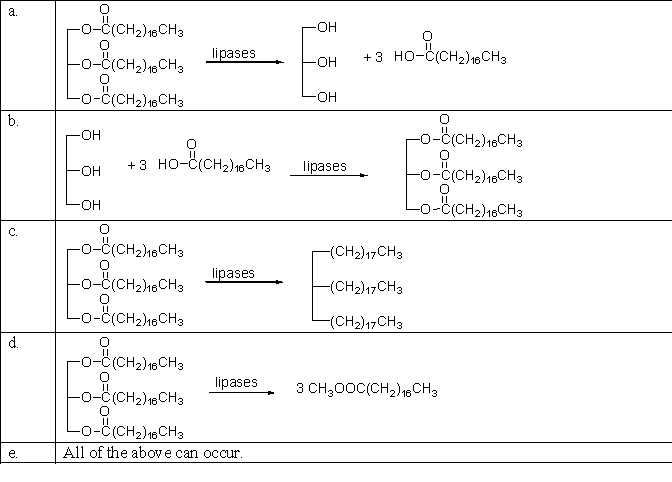
A) a
B) b
C) c
D) d
E) e

A) a
B) b
C) c
D) d
E) e

Unlock Deck
Unlock for access to all 108 flashcards in this deck.
Unlock Deck
k this deck
48
The bar graph below shows the percentage of saturated fats in a variety of triglycerides. Given this information, which triglycerides should be minimized in the diet? 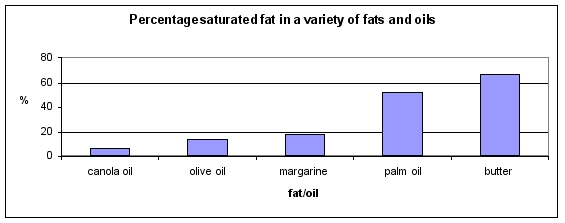
A) canola oil
B) butter
C) canola oil, olive oil, and margarine
D) margarine
E) palm oil and butter

A) canola oil
B) butter
C) canola oil, olive oil, and margarine
D) margarine
E) palm oil and butter

Unlock Deck
Unlock for access to all 108 flashcards in this deck.
Unlock Deck
k this deck
49
Which biomolecules provide the most energy per gram?
A) proteins
B) carbohydrates
C) triglycerides
D) Protein and carbohydrates provide more energy than triglycerides.
E) Proteins, carbohydrates and triglycerides provide the same amount of energy.
A) proteins
B) carbohydrates
C) triglycerides
D) Protein and carbohydrates provide more energy than triglycerides.
E) Proteins, carbohydrates and triglycerides provide the same amount of energy.

Unlock Deck
Unlock for access to all 108 flashcards in this deck.
Unlock Deck
k this deck
50
About how long do an average adult male's glycogen stores last?
A) about an hour
B) about a day
C) about a week
D) about a month
E) about 12 weeks
A) about an hour
B) about a day
C) about a week
D) about a month
E) about 12 weeks

Unlock Deck
Unlock for access to all 108 flashcards in this deck.
Unlock Deck
k this deck
51
Which of the following is NOT a purpose of the cell membrane?
A) to communicate with chemical messengers
B) to separate the contents of the cell from external fluids
C) to facilitate transport of nutrients and waste
D) to synthesize proteins
E) to protect the contents of the cell from undesirable chemicals
A) to communicate with chemical messengers
B) to separate the contents of the cell from external fluids
C) to facilitate transport of nutrients and waste
D) to synthesize proteins
E) to protect the contents of the cell from undesirable chemicals

Unlock Deck
Unlock for access to all 108 flashcards in this deck.
Unlock Deck
k this deck
52
About how long do an average adult male's fat stores last?
A) about an hour
B) about a day
C) about a week
D) several weeks
E) several years
A) about an hour
B) about a day
C) about a week
D) several weeks
E) several years

Unlock Deck
Unlock for access to all 108 flashcards in this deck.
Unlock Deck
k this deck
53
Degradation of dietary fats begins in the
A) mouth.
B) stomach.
C) small intestine.
D) colon.
E) liver.
A) mouth.
B) stomach.
C) small intestine.
D) colon.
E) liver.

Unlock Deck
Unlock for access to all 108 flashcards in this deck.
Unlock Deck
k this deck
54
Compared to fats and sugars, how much energy do fats supply?
A) Per gram, fats supply about half the energy of proteins and sugars.
B) Per gram, fats supply about twice the energy of proteins and sugars.
C) Per gram, fats supply about one-fourth the energy of proteins and sugars.
D) Per gram, fats supply about four times the energy of proteins and sugars.
E) Fats, sugars, and proteins all supply about the same amount of energy.
A) Per gram, fats supply about half the energy of proteins and sugars.
B) Per gram, fats supply about twice the energy of proteins and sugars.
C) Per gram, fats supply about one-fourth the energy of proteins and sugars.
D) Per gram, fats supply about four times the energy of proteins and sugars.
E) Fats, sugars, and proteins all supply about the same amount of energy.

Unlock Deck
Unlock for access to all 108 flashcards in this deck.
Unlock Deck
k this deck
55
Both of these lipids are found in 
A) cell membranes.
B) mitochondria.
C) proteins.
D) steroids.
E) soap.

A) cell membranes.
B) mitochondria.
C) proteins.
D) steroids.
E) soap.

Unlock Deck
Unlock for access to all 108 flashcards in this deck.
Unlock Deck
k this deck
56
Amphipathic molecules can interact with both lipids and water because they contain
A) an ester.
B) sphingosine.
C) polar regions and nonpolar regions.
D) cholesterol.
E) saturated fatty acids.
A) an ester.
B) sphingosine.
C) polar regions and nonpolar regions.
D) cholesterol.
E) saturated fatty acids.

Unlock Deck
Unlock for access to all 108 flashcards in this deck.
Unlock Deck
k this deck
57
Fatty acids are stored in _______ and undergo metabolism in_______.
A) lipoproteins; adipocytes
B) adipocytes; adipocytes
C) adipocytes; muscle cells
D) muscle cells; lipoproteins
E) lipoproteins; lipoproteins
A) lipoproteins; adipocytes
B) adipocytes; adipocytes
C) adipocytes; muscle cells
D) muscle cells; lipoproteins
E) lipoproteins; lipoproteins

Unlock Deck
Unlock for access to all 108 flashcards in this deck.
Unlock Deck
k this deck
58
In which of the following choices are the three molecules below correctly identified as polar, nonpolar or amphipathic? 

A) a
B) b
C) c
D) d
E) e


A) a
B) b
C) c
D) d
E) e

Unlock Deck
Unlock for access to all 108 flashcards in this deck.
Unlock Deck
k this deck
59
Which of the following statements best describes the importance of emulsification in fat digestion?
A) Emulsification breaks the fatty acids apart from glycerol, resulting in the absorption of the fat.
B) Emulsification is required to break up globules of insoluble fats so they can be hydrolyzed.
C) Emulsifiers are the molecules that actively transport fats into cells.
D) Emulsifiers transport fats through the bloodstream.
E) Emulsification transports electrons to lipase during hydrolysis.
A) Emulsification breaks the fatty acids apart from glycerol, resulting in the absorption of the fat.
B) Emulsification is required to break up globules of insoluble fats so they can be hydrolyzed.
C) Emulsifiers are the molecules that actively transport fats into cells.
D) Emulsifiers transport fats through the bloodstream.
E) Emulsification transports electrons to lipase during hydrolysis.

Unlock Deck
Unlock for access to all 108 flashcards in this deck.
Unlock Deck
k this deck
60
Where would you most likely find trans fats?
A) They are found in meat.
B) They are found in cheese.
C) They are found in butter.
D) They are found in plants.
E) They are found in margarine.
A) They are found in meat.
B) They are found in cheese.
C) They are found in butter.
D) They are found in plants.
E) They are found in margarine.

Unlock Deck
Unlock for access to all 108 flashcards in this deck.
Unlock Deck
k this deck
61
The component of a cell membrane shown below is a 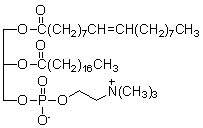
A) glycerophospholipid.
B) glycosphingolipid.
C) sphingomyelin.
D) triacylglycerol.
E) fatty acid.

A) glycerophospholipid.
B) glycosphingolipid.
C) sphingomyelin.
D) triacylglycerol.
E) fatty acid.

Unlock Deck
Unlock for access to all 108 flashcards in this deck.
Unlock Deck
k this deck
62
Which of the following figures best illustrates how the lipid bilayer would arrange itself in a nonpolar solution such as hexane? 
A) a
B) b
C) c
D) d
E) e

A) a
B) b
C) c
D) d
E) e

Unlock Deck
Unlock for access to all 108 flashcards in this deck.
Unlock Deck
k this deck
63
Lipid II contains which of the following functional groups not found in lipid I? 
A) amide
B) alcohol
C) alkene
D) amide and alcohol
E) amide, alcohol, and alkene

A) amide
B) alcohol
C) alkene
D) amide and alcohol
E) amide, alcohol, and alkene

Unlock Deck
Unlock for access to all 108 flashcards in this deck.
Unlock Deck
k this deck
64
A membrane lipid is often depicted as shown below in Lipid I. Which part of the molecular structure of Lipid I does the wavy line represent? 
A) Part A
B) Parts A and B
C) Parts A, C, and D
D) Parts C and D
E) Parts B and D

A) Part A
B) Parts A and B
C) Parts A, C, and D
D) Parts C and D
E) Parts B and D

Unlock Deck
Unlock for access to all 108 flashcards in this deck.
Unlock Deck
k this deck
65
The molecule that facilitates transport through the cell is indicated by the letter____ in the following illustration of a cell membrane. 
A) A
B) B
C) C
D) D
E) E

A) A
B) B
C) C
D) D
E) E

Unlock Deck
Unlock for access to all 108 flashcards in this deck.
Unlock Deck
k this deck
66
Generally, membrane lipids
A) contain a hydroxyl group.
B) contain more than one ester functional group.
C) have a sphingosine backbone.
D) have a glycerol backbone.
E) have a nonpolar and a polar region.
A) contain a hydroxyl group.
B) contain more than one ester functional group.
C) have a sphingosine backbone.
D) have a glycerol backbone.
E) have a nonpolar and a polar region.

Unlock Deck
Unlock for access to all 108 flashcards in this deck.
Unlock Deck
k this deck
67
What type of lipid is this molecule? 
A) This is a triacylglycerol.
B) This is a glycerophospholipid.
C) This is a glycosphingolipid.
D) This is a sphingomyelin.
E) This is a cerebroside.

A) This is a triacylglycerol.
B) This is a glycerophospholipid.
C) This is a glycosphingolipid.
D) This is a sphingomyelin.
E) This is a cerebroside.

Unlock Deck
Unlock for access to all 108 flashcards in this deck.
Unlock Deck
k this deck
68
The component of a cell membrane shown below is a 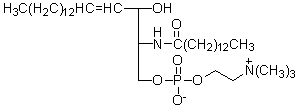
A) glycerophospholipid.
B) glycosphingolipid.
C) sphingomyelin.
D) triacylglycerol.
E) fatty acid.

A) glycerophospholipid.
B) glycosphingolipid.
C) sphingomyelin.
D) triacylglycerol.
E) fatty acid.

Unlock Deck
Unlock for access to all 108 flashcards in this deck.
Unlock Deck
k this deck
69
What type of lipid is this molecule? 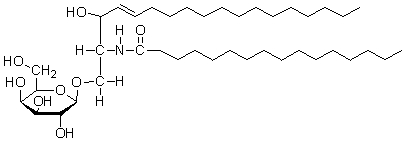
A) This is a triacylglycerol.
B) This is a glycerophospholipid.
C) This is a glycosphingolipid.
D) This is a sphingomyelin.
E) This is an ethanolamine.

A) This is a triacylglycerol.
B) This is a glycerophospholipid.
C) This is a glycosphingolipid.
D) This is a sphingomyelin.
E) This is an ethanolamine.

Unlock Deck
Unlock for access to all 108 flashcards in this deck.
Unlock Deck
k this deck
70
The following molecule is a cerebroside. What characteristics does this molecule have? 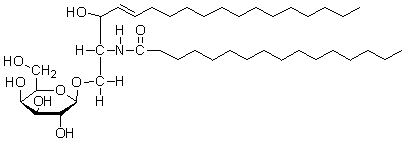
A) The molecule has a sphingosine backbone and a galactose sugar.
B) The molecule has a glycerol backbone and a galactose sugar.
C) The molecule contains an amine.
D) The molecule has a sphingosine backbone and a glucose sugar.
E) The molecule has a glycerol backbone and a glucose sugar.

A) The molecule has a sphingosine backbone and a galactose sugar.
B) The molecule has a glycerol backbone and a galactose sugar.
C) The molecule contains an amine.
D) The molecule has a sphingosine backbone and a glucose sugar.
E) The molecule has a glycerol backbone and a glucose sugar.

Unlock Deck
Unlock for access to all 108 flashcards in this deck.
Unlock Deck
k this deck
71
In the following illustration of a cell membrane, the molecules labeled (E) are 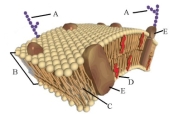
A) steroids.
B) proteins.
C) carbohydrate side chains.
D) phospholipids.
E) glycerophospholipids.

A) steroids.
B) proteins.
C) carbohydrate side chains.
D) phospholipids.
E) glycerophospholipids.

Unlock Deck
Unlock for access to all 108 flashcards in this deck.
Unlock Deck
k this deck
72
In the following illustration of a cell membrane, the molecule that acts as a receptor, communicating with molecules such as steroids, is represented by the letter 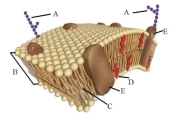
A) A.
B) B.
C) C.
D) D.
E) E.

A) A.
B) B.
C) C.
D) D.
E) E.

Unlock Deck
Unlock for access to all 108 flashcards in this deck.
Unlock Deck
k this deck
73
Glycerophospholipids typically contain unsaturated fatty acids because they
A) act as receptors for steroids.
B) have few attractive forces between them, making the membrane fluid.
C) have many attractive forces between them, making the membrane fluid.
D) have few attractive forces between them, making the membrane stiff.
E) have many attractive forces between them, making the membrane stiff.
A) act as receptors for steroids.
B) have few attractive forces between them, making the membrane fluid.
C) have many attractive forces between them, making the membrane fluid.
D) have few attractive forces between them, making the membrane stiff.
E) have many attractive forces between them, making the membrane stiff.

Unlock Deck
Unlock for access to all 108 flashcards in this deck.
Unlock Deck
k this deck
74
Parts of the lipid below are labeled A and B. Which choice best describes part A and part B? 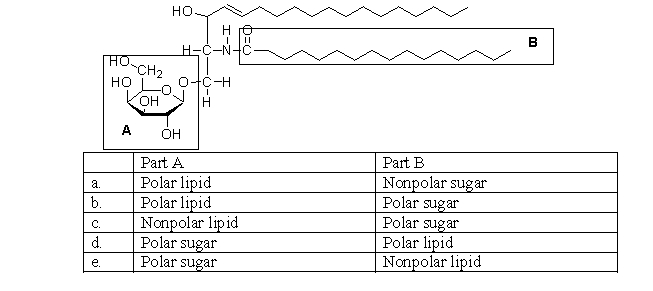
A) a
B) b
C) c
D) d
E) e

A) a
B) b
C) c
D) d
E) e

Unlock Deck
Unlock for access to all 108 flashcards in this deck.
Unlock Deck
k this deck
75
The type of molecules that make up the majority of the cell membrane are
A) phospholipids.
B) steroids.
C) transmembrane proteins.
D) carbohydrates.
E) cholesterol.
A) phospholipids.
B) steroids.
C) transmembrane proteins.
D) carbohydrates.
E) cholesterol.

Unlock Deck
Unlock for access to all 108 flashcards in this deck.
Unlock Deck
k this deck
76
A membrane lipid is often depicted as shown below in Lipid I. Which part of the molecular structure of Lipid I does the circle represent? 
A) Part A
B) Part B
C) Part C
D) Parts A and B
E) Parts B and C

A) Part A
B) Part B
C) Part C
D) Parts A and B
E) Parts B and C

Unlock Deck
Unlock for access to all 108 flashcards in this deck.
Unlock Deck
k this deck
77
What important role does sphingomyelin have in the body?
A) It insulates nerve fibers in the brain.
B) It is important in energy storage.
C) It is a chemical messenger.
D) It is the primary component of the lipid bilayer for all cells.
E) It lines the stomach.
A) It insulates nerve fibers in the brain.
B) It is important in energy storage.
C) It is a chemical messenger.
D) It is the primary component of the lipid bilayer for all cells.
E) It lines the stomach.

Unlock Deck
Unlock for access to all 108 flashcards in this deck.
Unlock Deck
k this deck
78
Which of the following statements best describes the lipid bilayer?
A) It is flexible and fluid-like.
B) It is held together by hydrogen bonds.
C) It is rigid and stiff.
D) It cracks easily.
E) All of the above are true.
A) It is flexible and fluid-like.
B) It is held together by hydrogen bonds.
C) It is rigid and stiff.
D) It cracks easily.
E) All of the above are true.

Unlock Deck
Unlock for access to all 108 flashcards in this deck.
Unlock Deck
k this deck
79
The lipid bilayer is fluid-like and flexible. Because of this, it is often described as
A) ductile.
B) fluid mosaic.
C) squashy.
D) supple elastic.
E) bendable membrane.
A) ductile.
B) fluid mosaic.
C) squashy.
D) supple elastic.
E) bendable membrane.

Unlock Deck
Unlock for access to all 108 flashcards in this deck.
Unlock Deck
k this deck
80
Lipid II is labeled A-D. Which of the labeled parts of this molecule comprise the sphingosine backbone? 
A) A only
B) A and B
C) B and C
D) A, B, and D
E) The sphingosine backbone is composed of all of the labeled parts of the molecule.

A) A only
B) A and B
C) B and C
D) A, B, and D
E) The sphingosine backbone is composed of all of the labeled parts of the molecule.

Unlock Deck
Unlock for access to all 108 flashcards in this deck.
Unlock Deck
k this deck



